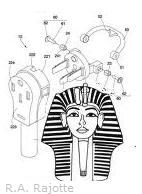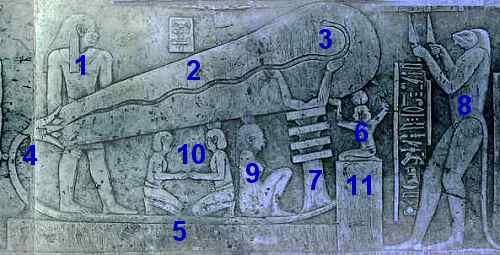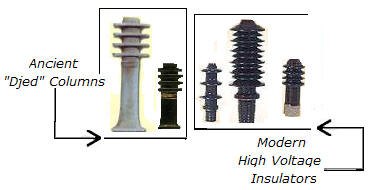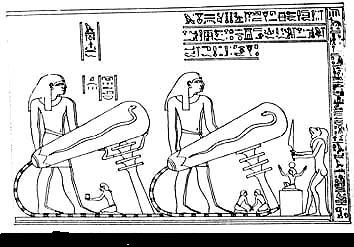 |
Electricity in Ancient Egypt and Rome
|
|
Content Electrical Ark of the Covenant Suggested Reading
|
Light Bulbs in Ancient Egypt
In an underground cavern below the Hathor-temple in Dendera, Egypt there are several relief's depicting ancient devices, these controversial relief's are known as the Dendera lights. Two arms reach into its bulbous rounded end, these arms are supported by columns which are called Djed Pillars or Tet Columns, but very much resemble high voltage insulators. At the thin end of the Dendera lights runs something resembling a cable into the glass bulb. Extending the length of the glass bulb is a snake hanging horizontally in the air. The whole arrangement bears an striking resemblance to an electric lamp. Many believe it is proof of Electricity in Ancient Egypt.
A Norwegian electrical engineer is credited as being the first to notice that the objects shown on the relief could conceivably work as a lamp, and an Austrian colleague constructed a working model. Both believe they have proof of Electricity in Ancient Egypt.
The Electric Mirror on the Pharos Lighthouse and Other Ancient Lighting
- A Monumental work which through a comprehensive layout of ancient coins, artifacts, monuments, and literature argues that the ancients used electricity to light up their temples, tombs, lighthouses, fortresses, palaces, cities and other edifices and critical areas. No other work on the subject documents as much ancient Egyptian, Sumerian, Babylonian, Hebrew, Assyrian, Indian, Greek, Roman, Parthian, Persian, and Sassanian as well as medieval evidence of the fact. Furthermore, the work recalls interesting details and descriptions (some of which have never before been translated into English) of the ancient Alexandrian Pharos Lighthouse and its reflective telescope and electric beacon.
Traditional Egyptologists claim that the relief's are of a religious / mythological nature. Traditional Egyptologists state that the Dendera lights are nothing more than a lotus flower, spawning a snake within., and that Electricity in Ancient Egypt would simply not be feasible.
As per The Traveler's Key to Ancient Egypt: [John Anthony West] "The splendid but enigmatic reliefs of the crypt are cosmological and depict the serpent borne aloft by the lotus, the symbol of creation as a manifestation of consciousness."
Radical Egyptologists, as well as pseudo-scientists believe that they represent electric lamps.
I have several problems accepting the traditional interpretation . The stem of a lotus flower does not grow horizontally along the ground as in the relief , going off to a mysterious source, and then rise suddenly and vertically at 180° angle to connect to a mysterious bulbous form. As a matter of fact , in most cases the stem of the Lotus flower is not seen at all, it is submerged. A lotus flower does not require devices strangely resembling high voltage insulators to support their weight. Nor does a Lotus flower extrude a glass or transparent bulbous shape as in the relief.
* The Djed Pillars or Tet Columns which resemble electrical insulators appear frequently in Egyptian Glyphs Theoretically simplified, they represent stability . As theoretically utilized by the priesthood they stabilized the flow of current which the priests utilized in religious ceremonies.

Das Licht der Pharaonen. Hochtechnologie und elektrischer Strom im alten Ägypten. [not yet available in English]
- Priest
- ionized fumes
- electric discharge [snake]
- Lamp socket [Lotos]
- Cable [Lotos stem]
- Air god
- Insulator [Djed-Pillar]
- Light bringer [Thoth with knifes]
- Symbol for "current"
- Inverse polarity
- Energy storage
Some scholars have theorized that the Djed represented a cedar tree with its branches removed to which stalks of wheat were tied after harvest. In Snefru’s step pyramid, the Djed pillars form columns supporting the sky and may represent the four pillars which help Shu bear the sky on his shoulders. The Djed may also represent a man’s backbone. In the story of Isis and Osiris, the Djed pillar is Osiris’ backbone which Isis found buried in Djedu
During the Old Kingdom, the Djed was associated with the creator god of Memphis, who was given the epithet ‘the Noble Djed’. Later they became closely associated with Osiris .

"[the Pharos Lighthouse] ... has no equal on the face of the earth," stated medieval Arab geographer and Historian Al Bakri [c. 1014–1094] " [the Alexandrians] assigned to its summit the celebrated mirror, which was made from a mixture of remarkable and extraordinary substances; they were able to see by it enemy ships on their way towards Alexandria, several days away, to prepare themselves for defense."
Georges Comte de Buffon (1707–1788) a famed French mathematician and naturalist wrote 'if the mirror really existed, as I firmly believe it did, to the ancients belong the honor of the invention of the telescope.'"
“That the Pharos was used as a signal-station as well as a lighthouse is certain, ... and at the time of the Arab conquest it was in full working order and flashed the sun by day and its own fire by night many leagues over the sea.” The Arab Conquest of Egypt and the Last Thirty Years of the Roman Dominion Dr. Alfred J. Butler,
In Isis Unveiled , H. P. Blavatsky pointed out that "Some modern writers deny the fact that a great mirror was placed in the light-house of the Alexandrian port, for the purpose of discovering vessels at a distance at sea ..."
354-430 AD - St. Augustine claimed that in an Egyptian temple dedicated to Isis (Venus), a lamp burned which neither wind nor water could extinguish. He said That in Egypt...
“There was, and still is, a temple of Venus, in which a lamp burns so strongly in the open air that no storm or rain extinguishes it.” He attributed this lamp to the miracles of the “black arts” performed by demons and men. - Secrets of the Lost Races
Rene Noorberg
Electrical Engineer John B. Varity, in Electricity Up to Date: For Light, Power, and Traction wrote: "Although the study of Electricity has only been developed within the last century, there is no doubt that its existence was known to the civilized world of 2000 years ago. It may well be that Electricity was the magic of the Ancients.."
13th Century AD - Eliphas Levi, in his 'Histoire de la Magie', records the story of a mysterious French Rabi named Jechiele, who was an advisor to Louis IX. Jechiele's contemporary's reported that he often astounded the King with his "Dazzling lamp that lighted itself". The lamp possessed no oil or wick, and Jechiele placed it in front of his house for all to see. Interestingly, another device he was reputed to have had was a door knocker that was ale to produce an electric shock. - Secrets of the Lost Races Rene Noorberg
“Whenever, in the pride of some new discovery, we throw a look into the past, we find, to our dismay, certain vestiges which indicate the possibility, if not the certainty, that the alleged discovery was not totally unknown to the ancients. It is generally asserted that neither the early inhabitants of the Mosaic times, nor even the more civilized nations of the Ptolemaic period were acquainted with electricity. If we remain undisturbed in this opinion, it is not for the lack of proofs to the contrary.” H. P. Blavatsky
Notes
Electricity In Other Ancient Civilizations
Amuluis was a ninth Century BC king of the ancient Italian city of Albalonga . Roman Historian Cassius Dio writes of him...
"Amulius, a descendant of Tibernius, displayed an overweening pride and dared to make himself a god; he went so far as to match the thunder with artificial thunder, to answer lightning with lightning and to hurl thunderbolts."
Ancient India
In the Prince's Library of Ujjain in India, there is a document called the 'Agastya Samshita', which hails from the first millennium BC. It contains a detailed description of how to construct an electric battery/cell. As well as some other techniques and applications which seem out of place considering the time period they are from.
“Place a well-cleaned copper plate in an earthenware vessel. Cover it first by copper sulfate and then moist sawdust. After that put a mercury-amalgamated-zinc sheet on top of an energy known by the twin name of Mitra-Varuna. Water will be split by this current into Pranavayu and Udanavayu. A chain of one hundred jars is said to give a very active and effective force.”
